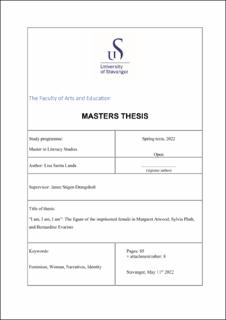| dc.description.abstract | This thesis is a comparative study exploring the theme of the imprisoned female in the three novels Alias Grace (1996) by Margaret Atwood, The Bell Jar (1963) by Sylvia Plath and Girl, Woman, Other (2019) by Bernardine Evaristo, which aims to explore and unpack the different ways in which the normative narratives presented by society bring about various forms of imprisonment for the female protagonists.
Historically, there have been ideals and expectations associated with the concept of “woman” and women have been under immense pressure to conform in order to become accepted members of society. Normative narratives, such as the ideology of patriarchy, have created and contributed to states of confinement and imprisonment for women and, not least, established language representing the narrative of female selfhood. The present study has conducted close readings and analysis of the three novels in order to see how these normative narratives have affected the female narrative of self, from the Victorian Period and up to the contemporary period. The novels, which were published in different time periods, all approach the issue of how normative narratives confine women in structures which do not necessarily correspond with their narrative of the self.
The close readings of the three novels will take their point of departure in the socio-cultural periods from which they emerge. The Victorian ideal woman was known as “the angel in the house” and became an object which should only be seen in the light of her husband. This concept was replaced by the so-called “beauty myth” in the twentieth century, which focused on the physical appearance of women. While the force of patriarchy has been in decline since the 1970s, however, further confining ideals in terms of sexuality, race and beauty still remain. | |
